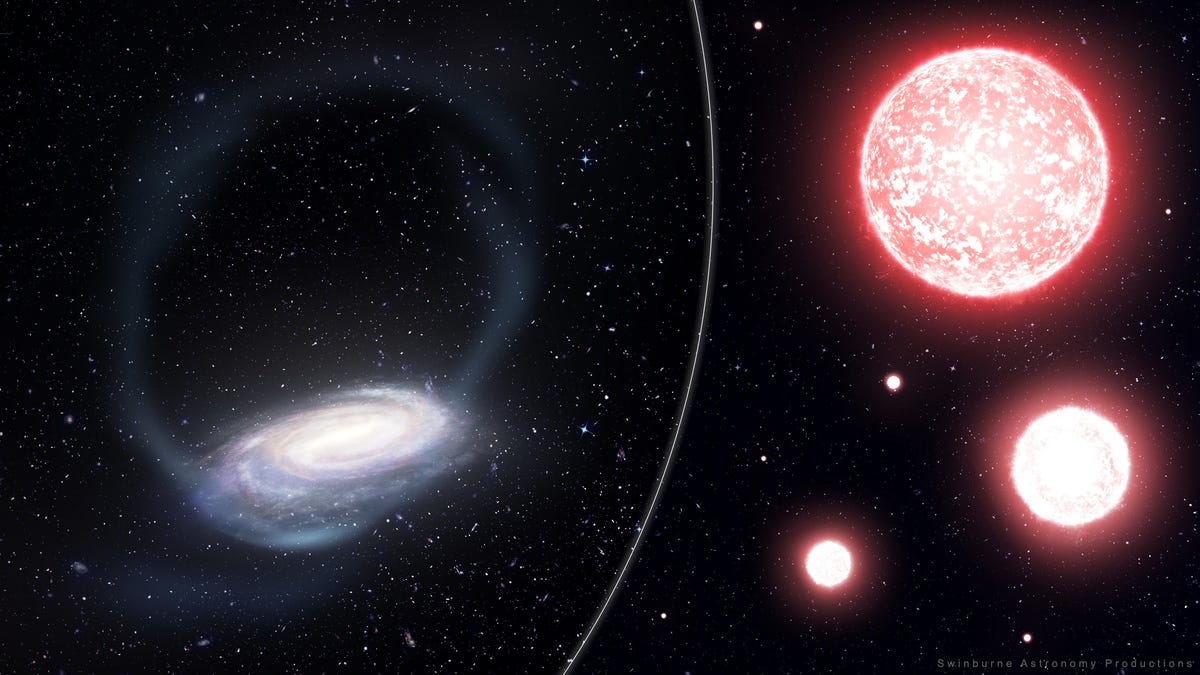Astronomers find a dying remnant from star cluster that 'shouldn't have existed'
The Phoenix stellar stream appears to have originated from a globular cluster unlike any we've seen in the Milky Way.

Left: The globular cluster ripped apart and streaming around the Milky Way. Right: The red giants that helped astronomers understand the cluster.
Sometime in the distant past, a clot of stars whipped through the Milky Way, and the galaxy's huge gravitational effects ripped them apart. Gravity molded the clot into a "big piece of spaghetti," full of stars, that constantly streams around our home galaxy.
New research, looking at this spaghetti-like stream of stars known as Phoenix, has shown its origins are highly unusual.
The study, published in the journal Nature on Wednesday, is part of a project to study stellar streams, like Phoenix, in the Milky Way and is known as the tongue-twisting "Southern Stellar Stream Spectroscopic Survey." The survey allowed the research team to focus in on Phoenix, discovered in 2016 during the Dark Energy Survey that scanned the skies between 2013 and 2019.
Phoenix was once a nice, clean ball of stars, held together by the forces of gravity... until it got too close to the Milky Way and was torn apart.
"Phoenix is a long, thin stream. It's 27,000 light-years long, but only 150 light-years across," says Geraint Lewis, an astronomer at the University of Sydney and one of the study's authors. "So it's a big piece of spaghetti, which is a definite sign that it's been totally ripped apart by the galaxy."
The stream, Lewis explains, comes from a globular cluster -- giant ball-shaped collections of 100,000 to a few million stars that orbit the Milky Way in a region of space known as the "stellar halo." The Milky Way hosts around 150 of these clusters, and they're well known to astronomers.
But the globular cluster that was ripped apart billions of years ago to form the Phoenix stream is peculiar.
"This stream comes from a cluster that, by our understanding, shouldn't have existed," said Daniel Zucker, an astronomer at Macquarie University, Australia, in a press release.
The team examined the spectrums of a dozen bright, red giant stars contained within Phoenix to understand their chemistry and decode which elements make them up. Most globular clusters that scientists know of contain elements heavier than hydrogen and helium which increases their "metallicity." In fact, astronomers studying clusters believe that they have a "metallicity floor" and that clusters can't form below this point.
But Phoenix consists of low-metallicity stars, which means the cluster it originated from extends below the metallicity floor.
"Its chemical enrichment is well below that of all the other globular clusters that exist," says Lewis.
That suggests an ancient origin for the globular cluster, when the universe was quite young, and points at the kind of environment the globular cluster may have formed in, one that no longer exists. We've caught Phoenix toward the end of its life, ground down by the gravity of the Milky Way into the thin spaghetti stream we see today.
"If we could have looked at the halo of the Milky Way billions of years ago, we'd have seen that there would be more objects like Phoenix," explains Lewis. "Phoenix is the last of its kind."
What fate awaits the stream? Eventually, it will disappear. The ever-present effects of gravity will start to disperse the high concentration of stars and it will fade into the stellar halo. But, Lewis says, it takes a few hundred million to a billion years to make another orbit of the Milky Way. So Phoenix will be hanging around for a while yet, and then, after another orbit or two, it'll be gone.
If we'd looked just a billion years later, we'd never know it existed at all.

